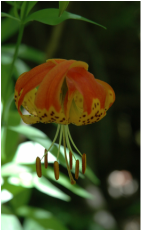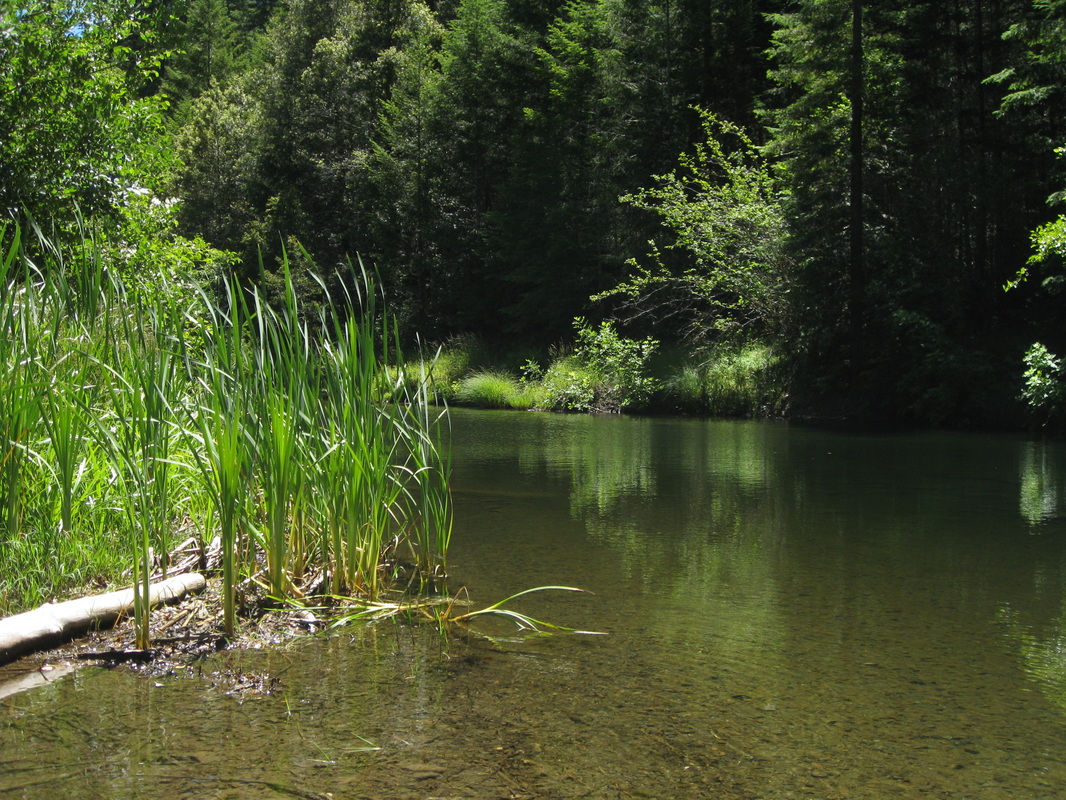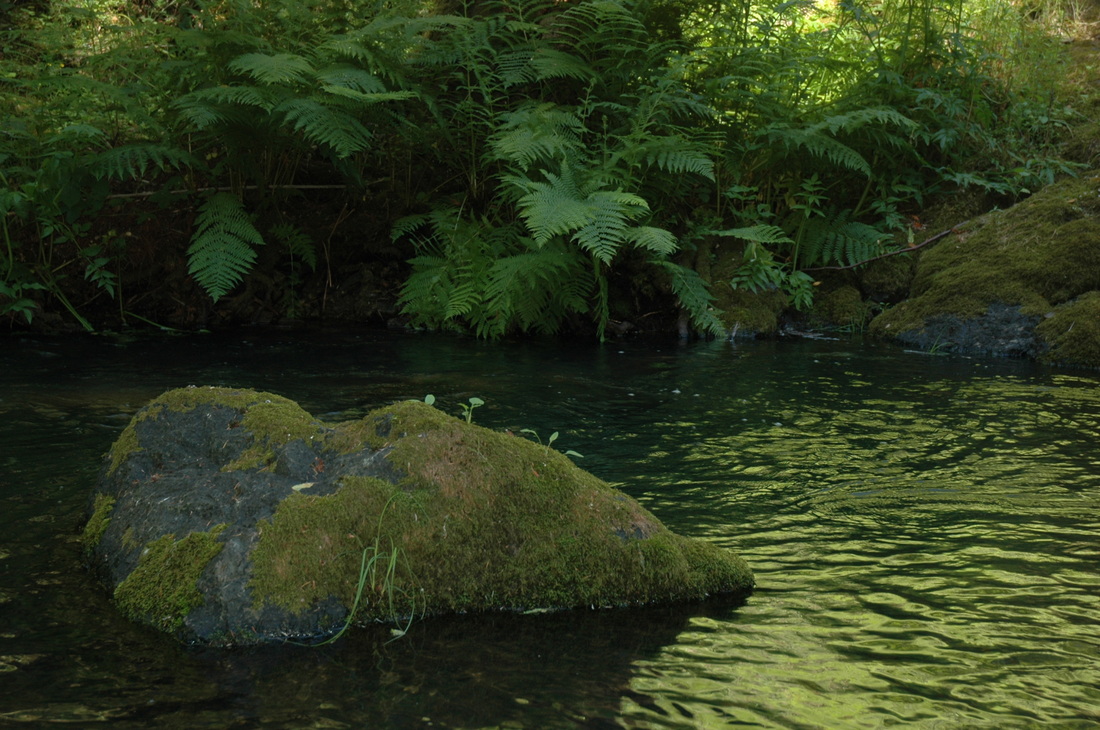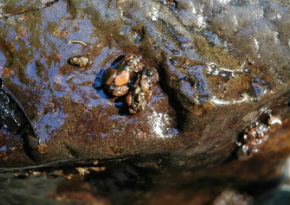| While on the Big Island we stayed at Hamp Carson's cabin in Glenwood. It has been several years since I was there and it still looks pretty much the same. It's great to have the resource available and we owe Ken Kaneshiro and the Center for Conservation Research and Training a huge mahalo for letting us stay there. The Big Island work stated in the Volcano area and along Stainback Highway. We also made collections for canacids along the Hamakua Coast, in Kau and in North Kona. We also spent a day helping Alli Quan collect Drosophila mimica and D. kambysellisi in Kipuka Puaulu. The rest of the time was spent on the Saddle Road collecting in kipukas along the Puu Oo Trail. |
|
We went to the Big Island and Maui to collect material for a couple different projects. My primary goal was to obtain samples of spoon tarsus species for our Dimensions in Biodiversity grant. I also wanted to obtain some more material from Scaptomyza cyrtandrae and a new species in that group from Maui that I'm describing with former student Jessica Craft. Finally, Nina and I were looking for canacids to expand the sampling within her phylogeny of Hawaiian Canacidae. It was a very successful trip and we got everything we needed for all the projects. We flew over to Maui for a short two day trip. The flight over was very smooth but there were some problems with the plane before we took off. We spent the first day collecting canacids and ephydrids along the Hana Highway. The second day was spent in the Waikamoi Forest Reserve. East Maui Irrigation gave us access and helped out with logistics. We ended up leaving some of our collections in the rental car but the folks at National sent them to us in Hilo via Air Cargo. In addition to all the hard work we also go to do some touristy stuff. The Halemaumau Crater was very impressive at night and Haleakala Crater is always amazing.
1 Comment
It's been a while since I've posted updates. My sabbatical has come and gone and much of what happened in the last half of it didn't get put up here. I'm going to try and catch up a bit - and do it in order - starting with this post. I made a number of collections around Memorial Day weekend. Chelsea and Paceyn were in Nebraska visiting family so I did a short road trip with my old friend Marty. The photo here is from an earlier trip but not much has changed. We had a great time and I also managed to get a large number of flies. Some Scaptomyza, but mostly ephydrids.
 Paceyn and I took a short hike in Florida Canyon this morning. The USFS trail guide said that this was a lightly used area but by the time we got to the trailhead, the parking lot was packed. There were license plates from 9 different states. We met lots of people on the trail and there was evidently some rare bird spotted in the area. So much for lightly used. We followed the main trail for about 1/2 mile then took a smaller one up the wash. I had been here in 1995 or so and had collected a bunch of Scaptomyza. My goal for today was to see if they were still there and to try and collect some ephydrids as well. There was a surprising amount of water in the canyon and we ended up at a small dam that was packed with moss, algae and aquatic plants. The Scaptomyza were still there, as were some leaf mines. I got a good mixture of different flies including Scaptomyza, ephydrids, bibionids, tipulids and syrphids.  Paceyn was a great help. She loved scrambling around on rocks in the wash and collecting plants and rocks. We had a great picnic and made our way back to the car with plenty of time to explore the neighboring Madera Canyon. There weren't any opportunities of collect there but hopefully on a future trip I can find some good spots.  Chelsea, Paceyn and I did a short drive on Sunday out toward the town a Arivaca. Our first stop was the Longhorn Grill, just off I-19. Although this place is closed now, it still attracts a lot of attention and is good place to stretch your legs before heading west on the smaller roads. The road heads west from Arivaca Junction to the town of Arivaca. This is one of the oldest settlements in the area and has a great coffee place. The Buena Vista National Wildlife refuge is also just outside of town. From Arivaca, we took Ruby Road toward the ghost town of Ruby, AZ, the site of an extensive silver mine. We stopped for some collecting just past Ruby where California Gulch crossed the road. There was some water in the wash and I was able to collect ephydrids, dolichopodids, chironomids, chloropids and several other families of flies. It was a good trip and I hope that the ephydrids are useful in some of the biogeographic work I've started in the western US. Paceyn was a huge help spotting flies and "fishing" in the wash. The lab has been funded as part of a large grant (led by Rosie Gillespie) to examine the origins of Hawaiian biodiversity. Here's a link to the announcement on the ESPM web page.
Not many people get paid to be twelve years old, at least not as adults, so I feel I’m one of the lucky ones. I’ve been working on a project that lets me go to so some beautiful rivers and streams, flip over rocks, and look for aquatic insects. It kindles the fun and curiosity that I remember while doing that kind of thing when I was a kid. Now, of course, I have a research question in mind while I’m out there. Our lab has been conducting surveys of aquatic insects in a few representative Northern California watersheds to establish the composition of aquatic insect communities, create a DNA barcoding (see this blog, too) database of Norcal aquatics for more efficient biomonitoring in the future, link taxa to characteristics of the habitat, and, using landscape genetics, make predictions about how global change biology may affect our local rivers and streams.
Aquatic insects have been used in biomonitoring for about a century as a way to assess the health of riparian areas. Biomonitoring adds informative data to chemical testing of water. Chemical testing provides valuable information about a particular component, such as dissolved oxygen or the concentration of a pollutant, at one moment in time. Biomonitoring is a way to assess whether all of the components of a system are such that they support the surveyed organisms over their entire lifespan. Both chemical and biological surveys can be combined to give a fuller picture of ecosystem health. Biomonitoring of aquatic insects is now being used not only to assess current and past ecosystem health, but also to predict future changes, for example in response to climate change. In recent years, concerns about the effects of human-driven climate change on riparian ecosystem have increased. Climate change is projected to alter precipitation patterns, the timing of seasonal transitions, and extremes of both heat and cold, among other effects. These changes will affect different members of biotic communities differently according to their ability to adapt to changing conditions or disperse to more favorable habitat. We can use species distribution modeling to identify key characteristics of favorable habitat, and use patterns we find today using landscape genetics to identify potential obstacles that could prevent taxa from shifting ranges. We are fortunate to be doing this as part of a larger consortium on campus, the Berkeley Initiative in Global Change Biology, or BIGCB. With funding from the Vice Chancellor’s Office, the Moore Foundation and the Keck Foundation, the BIGCB is focused on global change forecasting for California ecosystems, using analyses of fossil, historic and current data to better understand California ecosystems responses to environmental change and make predictions of future ecosystem changes. Brian Ort
 Collecting in the South Fork of the Eel River Mike, Brian and I traveled to Angelo Coast Reserve on the 19th to do some collecting. Our goals were to collect some aquatic insects in the Eel River and look for Scaptomyza species in the surrounding riparian zones. We didn't see any Scaptomyza but we got a great sample of aquatics, including lots of Dicosmoecus, Neophylax and Calineuria.  Brian collecting in Dutch Bill Creek This week we made two short field trips to collect aquatic insects. On Tuesday we worked northwest of Sebastapol. Brian and I visited several sites we had collected last fall. Our first stop was Pyrrington Creek on Graton Road, followed by Dutch Bill Creek along the Occidental Highway. We stopped for lunch at Stumptown Brewpub in Guerneville. After lunch we drove north of the Russian River to Austin Creek near the town of Cazadero. Our last stop of the day was Salmon Creek, northwest of the town of Bodega. Thursday we did a half day trip to two streams in Marin County, Lagunitas Creek and Pine Gulch Creek in Bolinas. Thanks to Sarah Hake for allowing us access to Pine Gulch Creek! We collected Neophylax here, as well as three species of Scaptomyza!! |
PatrickProfessor Archives
April 2018
Categories
All
|































 RSS Feed
RSS Feed
